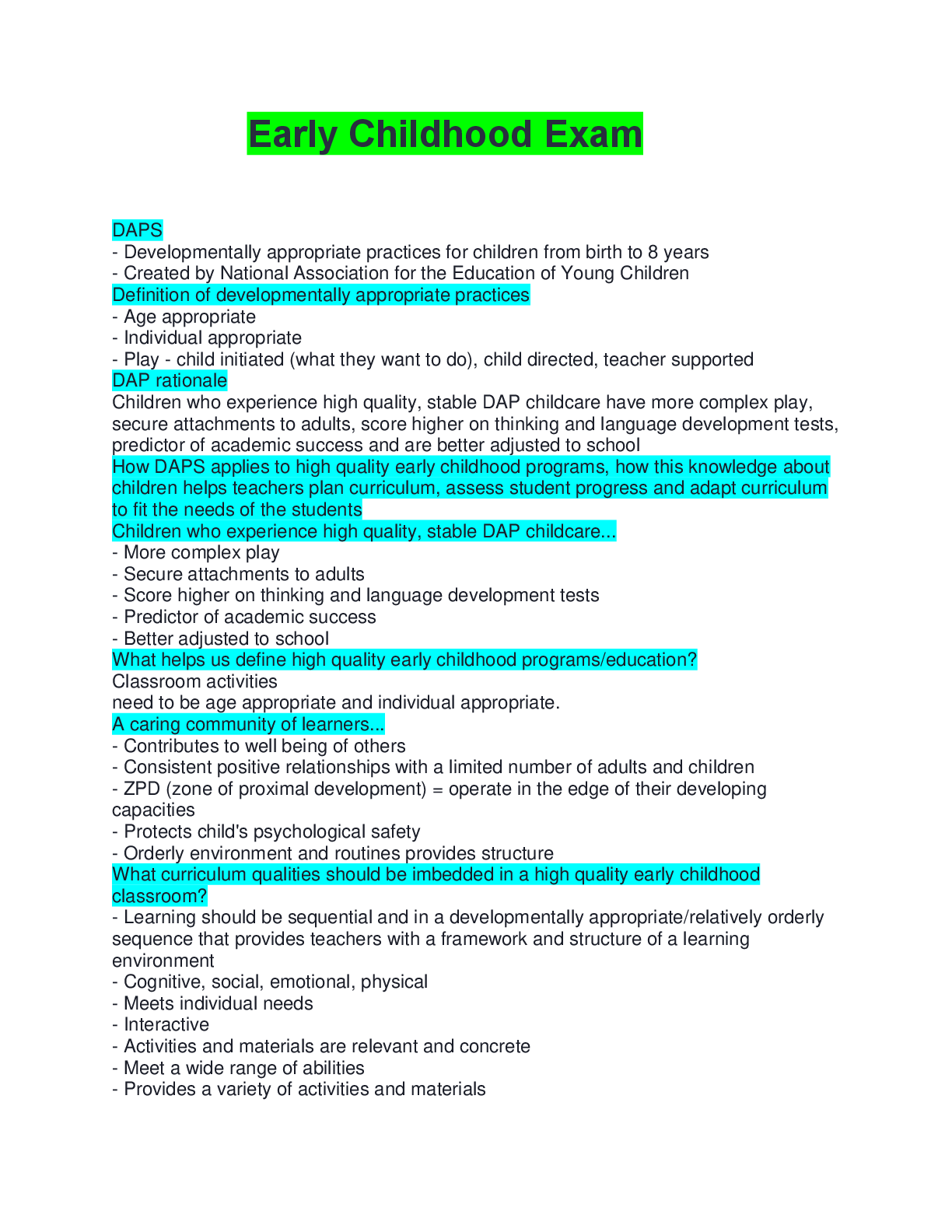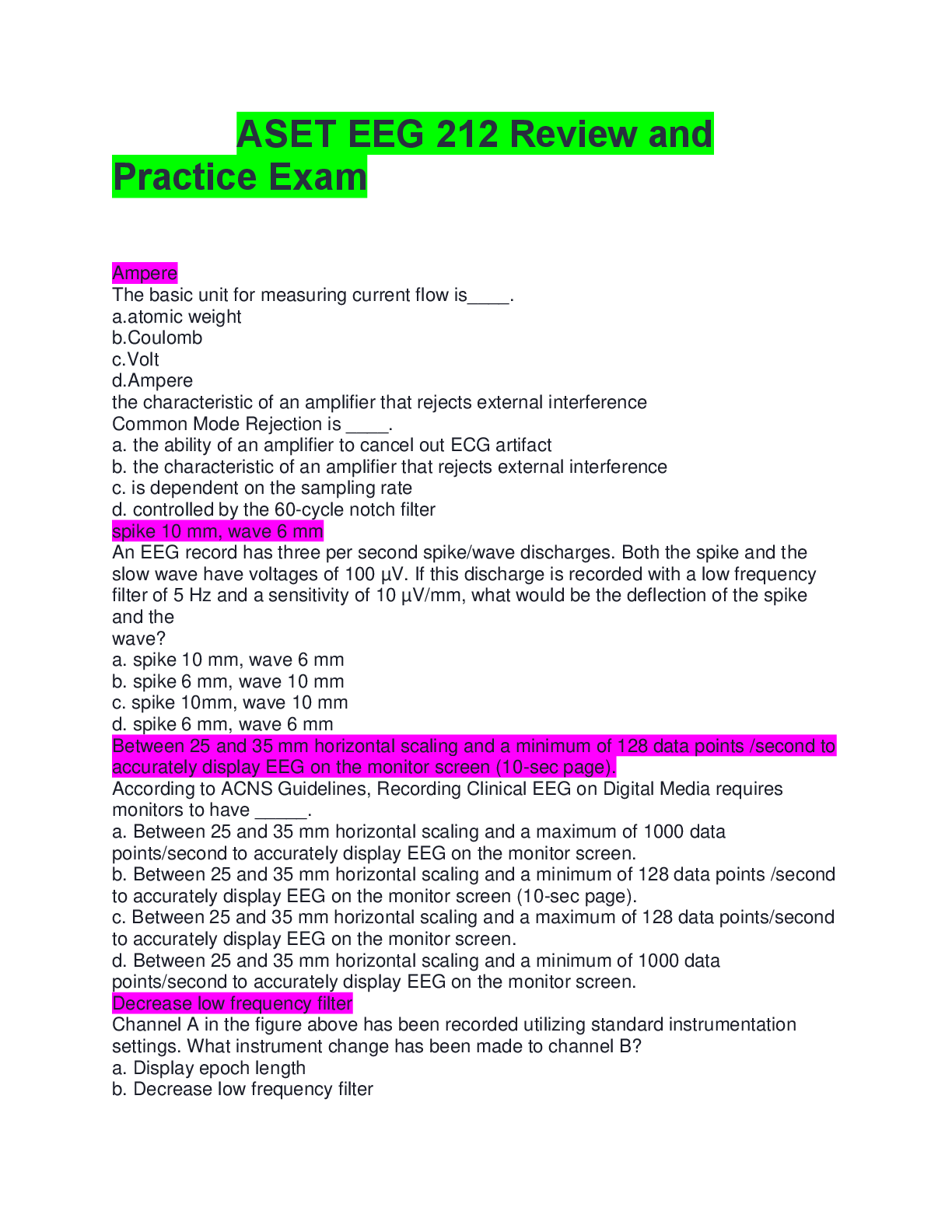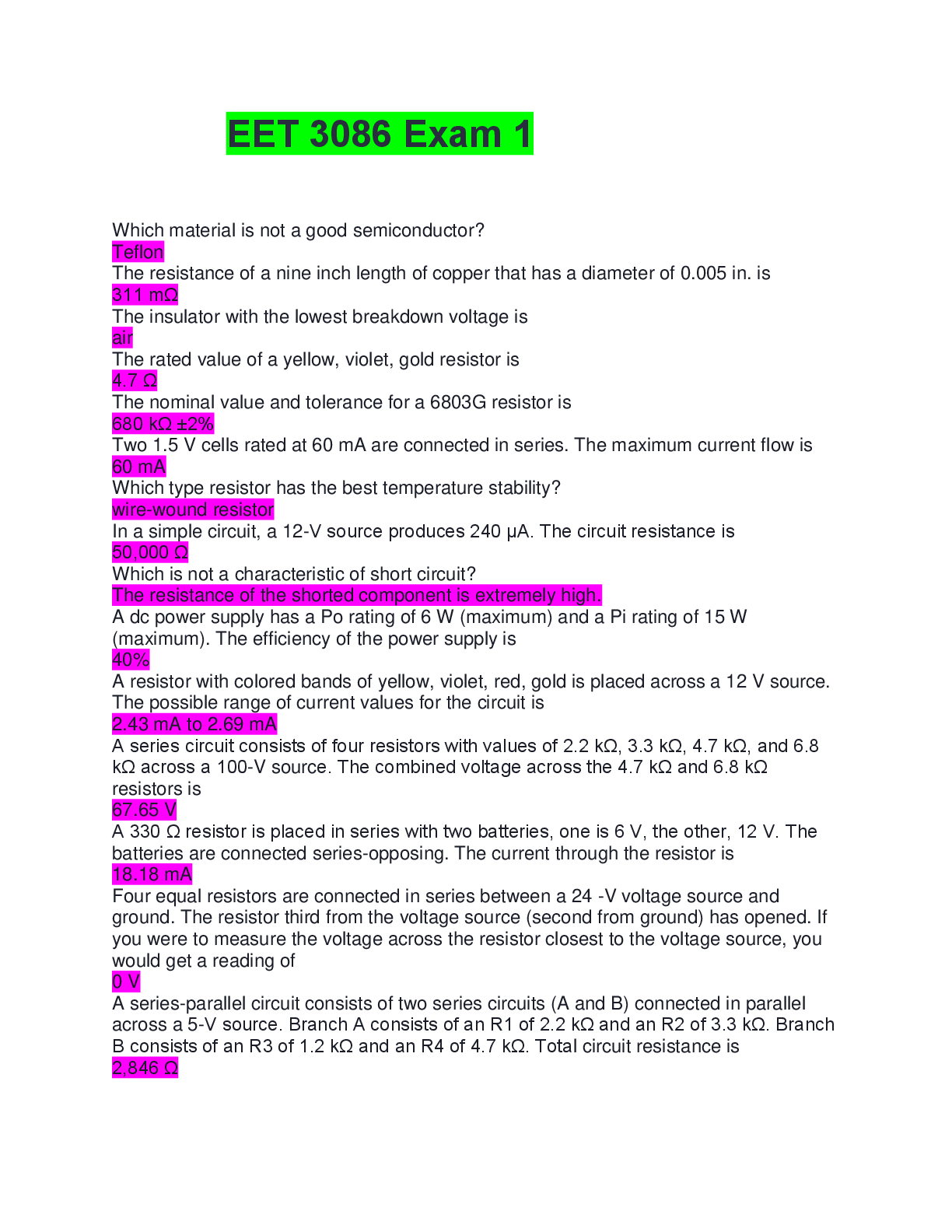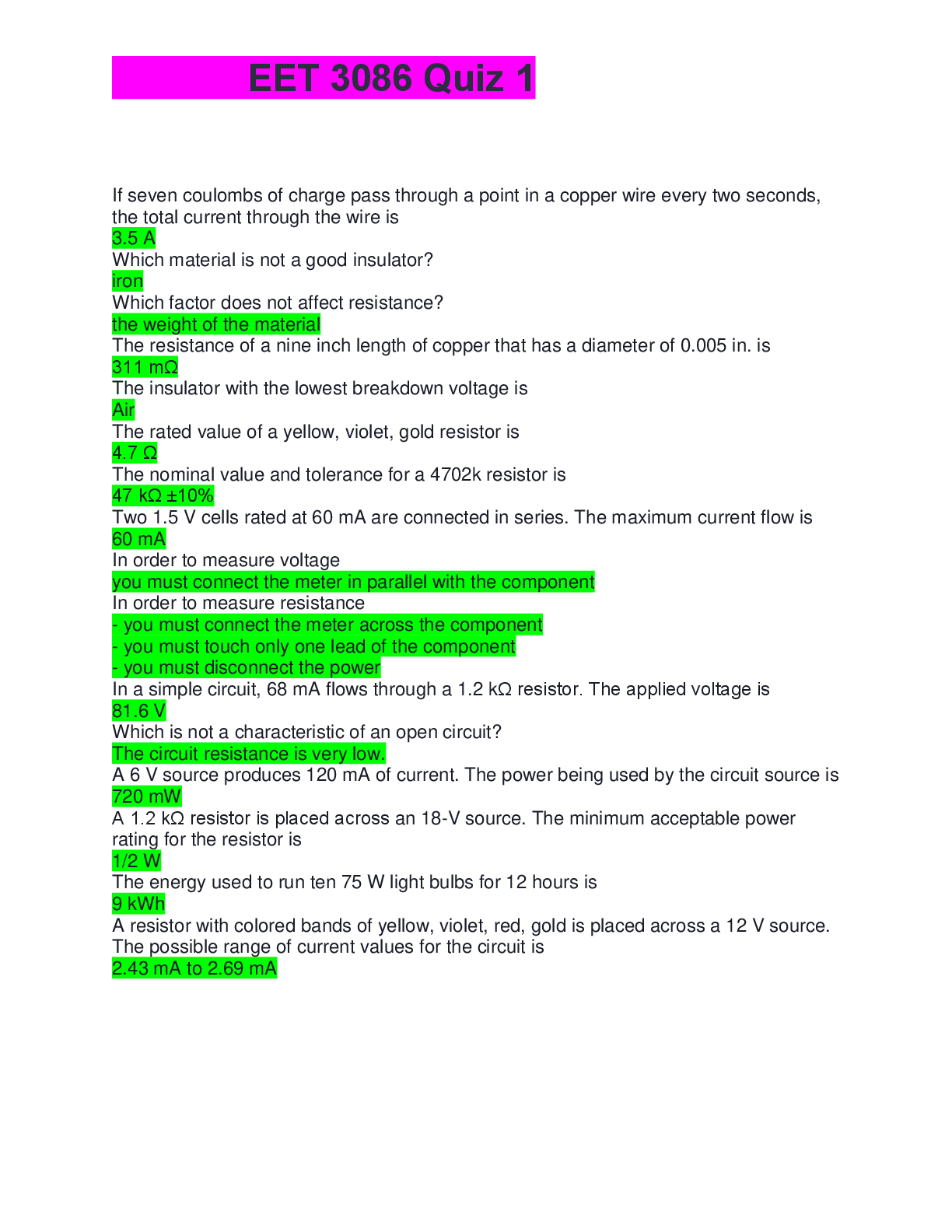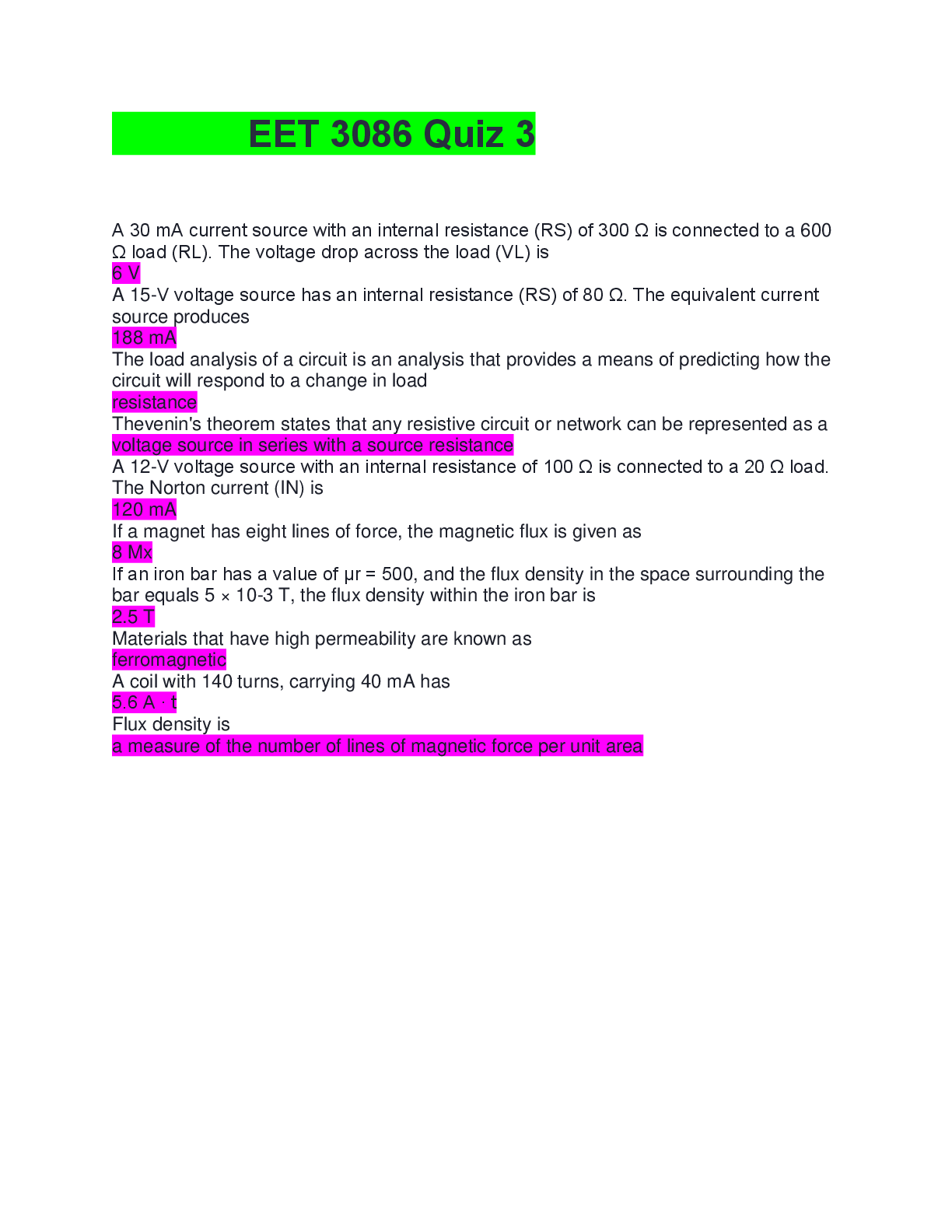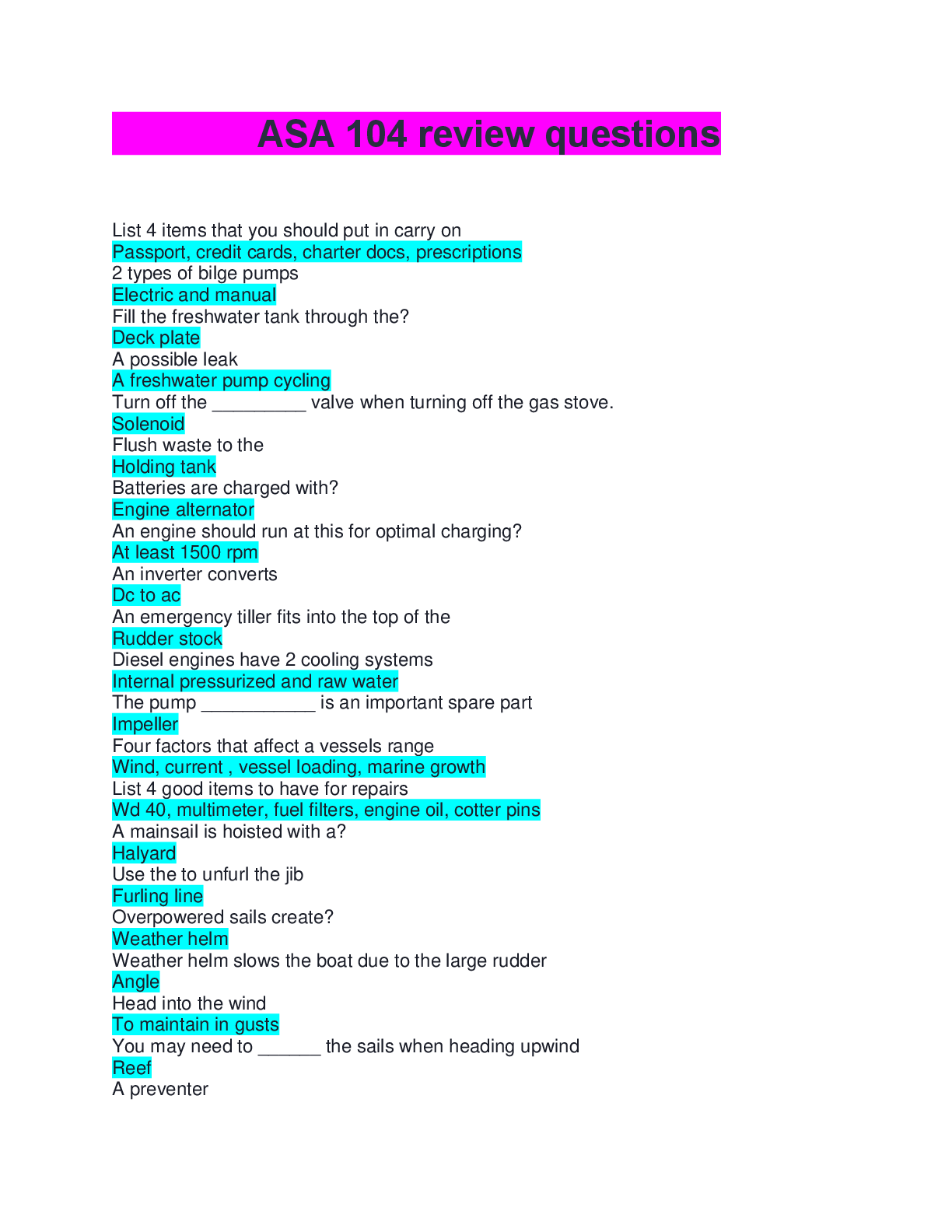Chemistry > EXAM > CHEM 120 Chapter 1 Review Problems (GRADED A+) Introduction to Chemistry: Bauer, Birks, & Marks | 10 (All)
CHEM 120 Chapter 1 Review Problems (GRADED A+) Introduction to Chemistry: Bauer, Birks, & Marks | 100% CORRECT
Document Content and Description Below
Chapter 1 Review Problems Introduction to Chemistry: Bauer, Birks, & Marks 1. A 1-ounce serving of Cheetos has 2.90 × 102 mg of sodium. What is this mass in units of grams? 2.9 x 102 mg Na x 1 ... g/1000 mg = 2.9x10-1 g or 0.290 g 2. How many pounds of noodles are in a can that contains 418 g? (1 lb = 453.6 g, 2.205 lb = 1 kg) 418 g x 1 lb/453.6 g = 0.922 lb 418 g x 1 kg/1000 g x 2.205 lb/1 kg = 0.922 lb 3. A 1-ounce serving of Doritos has 17 g of carbohydrates. What is this mass in units of ounces? (16 oz = 1lb, 1 lb = 453.6 g, 16 oz = 453.6 g) 17g x 1 lb/453.6 g x 16 oz/lb = 0.6 oz 17g x 16 oz/453.6g = 0.6 oz 4. A can of cashews has a mass of 8.5 ounces. What is this mass in kg? (16 ounces = 453.6 g) 8.5 oz x 453.6 g/16 oz x 1 kg/1000 g = 0.24 kg 5. What is the mass in kilograms of a copper pipe that weighs 12.5 pounds? (1 lb = 453.6 g, 2.205 lb = 1 kg) 12.5 lb x 453.6 g/lb x 1 kg/1000g = 5.67 kg 12.5 lb x 1 kg/2.205 lb = 5.67 kg 6. A typical light-weight bicycle weighs 17.5 pounds. What is the mass of a typical bike in kilograms? (1 lb = 453.6 g, 2.205 lb = 1 kg) 17.5 lb x 453.6 g/lb x 1 kg/1000g = 7.94 g 17.5 lb x 1 kg/2.205 lb = 7.94 kg 7. A bottle of cola has a volume of 591 mL. What is this volume in L? 591 mL x 1 L/1000mL = 0.591 L 8. A bottle of cola has a volume of 591 mL. What is this volume in fluid ounces? (1 fluid ounce = 29.57 mL) 591 mL x 1 fl oz/29.57 mL = 20.0 fl oz 9. A box has dimensions of 4.0 cm by 8.5 cm by 2.0 cm. Calculate the volume of the box in mL. (1 cm3 = 1 mL) Volume (V) = L x W x H: V = (4.0 cm)(8.5 cm)(2.0 cm) = 68 cm3 x 1 mL/cm3 = 68 mL A key learning here is that a box that measures 1.0 cm by 1.0 cm by 1.0 cm = 1 cm3. This volume holds exactly 1 mL. Notice also that we are working with volume and not area. Volume is a cubic parameter whereas area is a squared parameter (e.g., length x width). 10. A box has dimensions of 2.5 cm by 3.0 cm by 4.0 cm. Calculate the volume of the box in milliliters and liters. Volume (V) = L x W x H: V = (2.5 cm)(3.0 cm)(4.0 cm) = 30 cm3 x 1 mL/cm3 = 30 mL x 1 L/1000 mL = 0.030 L 11. The proprietor of a rock shop insists that a nugget is pure gold. If the nugget occupies a volume of 5.40 mL, what would its mass have to be if it were truly pure gold? (D gold = 19.3 g/mL) Here we are given the density of gold. We are also given a volume of the “gold” rock, as suggested by the shop owner. We have the density formula: density = mass/volume (D = m/V). We can manipulate this equation three ways: (a) D = m/V, (b) DV = m, & (c) V = m/D. Since we are asked to provide mass, we will use the second equation DV = m: m = (19.3 g/mL)(5.40 mL) = 104 g 12. If the density of a certain alcohol is 0.785 g/mL, what volume of the alcohol would have a mass of 75.0 g? Going back to our three versions of the density equation, we have (a) D = m/V, (b) DV = m, & (c) V = m/D. Here we are given both mass and density of this unknown alcohol and are asked to find the volume. We chose the third equation V = m/D: V = (75.0 g)/(0.785 g/mL) = 95.5 mL We need to understand the algebra here. When we have (A)/(B/C) it can be rewritten as A x C/B or AC/B. In this case, “C” is our unit of mL. 13. The density of aluminum is 2.7 g/cm3 (2.7 g/mL). What is the mass of a piece of aluminum foil which is 10.0 cm by 5.0 cm by 0.0018 cm thick? The approach here is to find the volume of the aluminum piece. Then we will use the density equation to solve for mass. Volume (V) = L x W x H: V = (10.0 cm)(5.0 cm)(0.0018 cm) = 0.09 cm3 x 1 mL/cm3 = 0.09 mL Going back to our three versions of the density equation, we have (a) D = m/V, (b) DV = m, & (c) V = m/D. Here we have both volume (calculated) and density of this aluminum (Al) piece and are asked to find the mass. We chose the 2nd equation m = DV: m = (2.7 g/mL)(0.09 mL) = 0.24 g 14. A student exploring the desert finds a piece of metal with a volume of 29.9 cm3(29.9 mL). If this metal has a mass of 337.5 g, which of the following is the metal most likely to be? A) aluminum (density = 2.70 g/cm3) B) sodium chloride (density = 2.16 g/cm3) C) lead (density = 11.3 g/cm3) D) gold (density = 19.3 g/cm3) E) The student discovered a new metal with a density of 0.0886 g/cm3. This is a fairly typical density problem in general chemistry. The strategy here is to determine the density of the unknown metal and then compare it to a list of known metal densities in the choices give. Here we use our first density equation: D = m/v D = (337.5 g)/(29.9 cm3) = 11.3 g/cm3 = 11.3 g/mL Looking at our choice, we deduce that option C (lead – Pb) is our answer here. 15. If a balloon filled with helium were heated with a blow-dryer, the balloon would increase in volume. What would happen to the density of the helium in the balloon? A) It would decrease. B) It would increase. C) It would remain the same. D) A chemical reaction would occur, so it is impossible to predict. E) The initial statement is incorrect—the volume of the balloon would not increase. Let’s think about what is happening here. We have a balloon that is filled with a fixed amount of helium (He). We then apply heat (thermal energy) to the balloon, which causes the gas molecules to vibrate more and expand the balloon’s volume. Have we added any new He? No. The only change is that the volume expanded. The density parameter is temperature dependent. In general, the warmer the temperature, the lower the density, which is what we have here. In the D = m/V expression, on the V term is increasing. Therefore, density must be going down. Choice A. 16. If the temperature of a bowl of ice cream increases from −10°C to 25°C, what is the increase in temperature in units of degrees Celsius and Kelvin? Here we are looking first for the temperature increase. We define a change in temperature (t) as the final temperature minus the initial temperature: t = tf – ti or sometimes t = t2 – t1: t = 25 oC – (-10o C) = 35o C. This is part 1. We have the relationship of Kelvin (K) = oC + 273.15. For each of the temperatures given we need to add 273.15 to get Kelvin. Our initial temperature will be -10 oC + 273.15 = 263.15 K. Our final temperature will be 25 oC + 273.15 = 298.15 K We now do the same to find tK = 298.15 K – 263.15 K = 35 K. Notice the temperature differences are the same, that is because K and C are related by addition – a constant. 17. The number 0.005925 correctly expressed in scientific notation is: We first have to put a decimal point to the right of the first non-zero digit, which is “5” here. Then we count the number of places to the original decimal point, which is 3 to the left and include all non-zero numbers to the right. Unless we are told to round our answer, the answer here is 5.925 x 10-3. Anytime a number is less than 1, the power of 10 in the scientific notation will be negative. 18. The number 54,900 correctly expressed in scientific notation is: We place a decimal point to the right of “5” and count the number of places to the right, which is 4 to the right and include all non-zero numbers to the right. Our answer here is 5.49 x 104. Numbers greater than 1 will have powers of 10 that are positive. 19. The correct answer for the product (6.45 × 105) × (1.2 × 104) is: (considering significant figures) Let’s first do the multiplication. Taking out of scientific notation, we have: 645,000 x 12,000 = 7,740,000,000 – this is too big a number, so we use scientific notation: 7.74x109. The question now is the answer 7.740x109 or 7.7400x109 or 7.74x109 or 7.7x109? This is where significant figures come into play. For multiplication and division operations, the final result cannot be any more precise than the least precise number. Here we have 6.45 and 1.2 (we don’t worry about the powers of ten). We say that 1.2 is less precise than 6.45, which has values out to the hundredths place. Expressed differently, we would say that 6.45 has (3) significant figures and 1.2 has (2) significant figures. Our answer here would be 7.7 x109. 20. The correct answer for the product (8.2 × 10−3) × (2.84 × 105) is: (considering significant figures) Without looking at the powers of ten and knowing this is multiplication, “8.2” has two significant figures and “2.84” has three significant figures. Our answer, therefore, cannot have more than two significant figures: 0.0082 x 284,000 = 2328.8. Since the numbers are in scientific notation, our result is 2.3288 x 103. Since we are only allowed (2) significant figures, we get 2.3 x 103. For the sake of instruction, if our answer would have been 2.3588 x 103 or 2.3688 x 103 or 2.3788 x 103 or 2.3888 x 103 or 2.3988 x 103, then would have to round up to 2.4 x 103 21. What is the correct answer to the following mathematical operation expressed to the appropriate number of significant figures? Ignoring the powers of ten, let’s look at each number. The same rules apply for both multiplication and division problems. The number “3.225” has (4) significant figures. The number “7.3” has (2) significant figures. What about 0.01? This can be rewritten as 1 x 10-2, which has (1) significant figure. Notice that there are no zeroes to the right of 0.01. With decimals, we do not consider leading zeroes as significant, but we do consider zeroes to the right as significant. A number like 0.0100 would be rewritten as 1.00x10-2, which has (3) significant figures. Our answer here after doing the operations is 4.4178x1019. Because we are only allowed (1) significant figure because of the 0.01, our final answer is 4x1019 22. The correct answer for the addition 56.234g + 0.0021 g is: (considering significant figures) Looking at our numbers, “56.234” has three numbers to the right of the decimal and “0.0021” has (4). Our answer must be reported with (3) decimals: 56.234 +0.0021 56.2361 56.236 g 23. The correct answer for the addition 102.5 mL + 6.55 mL is: (considering significant figures) The number “102.5” has (1) digit to the right of the decimal and “6.55” has (2) to the right of the decimal. Our answer needs to be reported only out to the tenths place, even though it is a zero. 102.5 + 6.55 109.0 mL 24. If a jet's cruising altitude is 32,200 ft (to three significant figures), calculate this distance in km. (1 mile = 1.61 km; 1 mile = 5280 ft) 32200 ft x 1 mi/5280 ft x 1.61 km/mi = 9.81561 km. All the numbers in the calculation have (3) significant figures. Our answer is 9.82 km. 25. If a car is traveling at 97 km/hr, what is its speed in mi/hr? (1 mile = 1.61 km) 97 km/hr x 1 mi/1.61 km = 60.248 km/hr. Since we have (2) significant figures (SF) with “97” and (3) significant figures with “1.61”, our answer needs to have (2) SF: 6.0 km/hr. 26. The American Heart Association recommends that for every 1000 dietary calories consumed, the sodium intake should be 1000 mg or less and should not exceed a daily limit of 3300 mg for an adult. What is the yearly limit on sodium intake in pounds? If the daily limit is 3300 mg Na, we can write this as 3300 mg/day. To find the yearly limit, we assume a year has 365 days: 3300 mg/day x 365 days/yr = 1.2045x106 mg/yr We now need to convert mg to lb: 1.2045x106 mg/yr x 1 kg/1,000,000 mg x 2.2 lb/kg = 2.65 lb. Since “3300” has (2) SF, our answer is 2.7 lb Na/yr. [Show More]
Last updated: 3 years ago
Preview 1 out of 5 pages
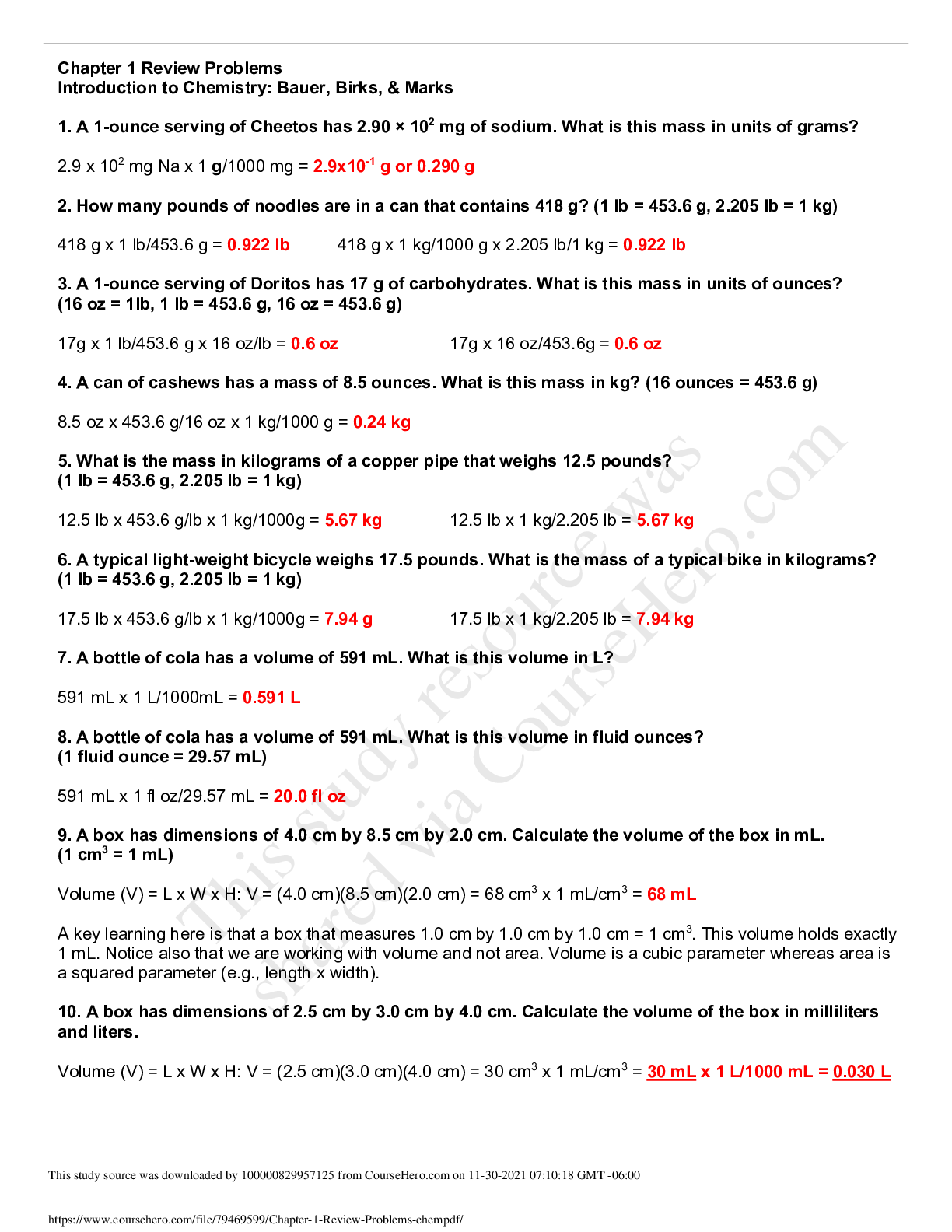
Buy this document to get the full access instantly
Instant Download Access after purchase
Buy NowInstant download
We Accept:

Also available in bundle (1)
Click Below to Access Bundle(s)

CHEM 120 Exams: Quizzes, Midterm, Final Exam Plus TEST BANK (Collection) | All The Paper you need to ACE in your exams | Download To Score An A.
CHEM 120 Unit 1 Quiz (100% Correct Solutions) CHEM-120 Unit 2 Quiz (100% Correct Solutions) CHEM 120 Unit 3 Quiz (100% Correct Solutions) CHEM-120 Unit 4 Midterm Exam (Collection) CHEM 120...
By Prof. Goodluck 4 years ago
$14.5
13
Reviews( 0 )
$10.00
Can't find what you want? Try our AI powered Search
Document information
Connected school, study & course
About the document
Uploaded On
Nov 30, 2021
Number of pages
5
Written in
All
Additional information
This document has been written for:
Uploaded
Nov 30, 2021
Downloads
0
Views
110


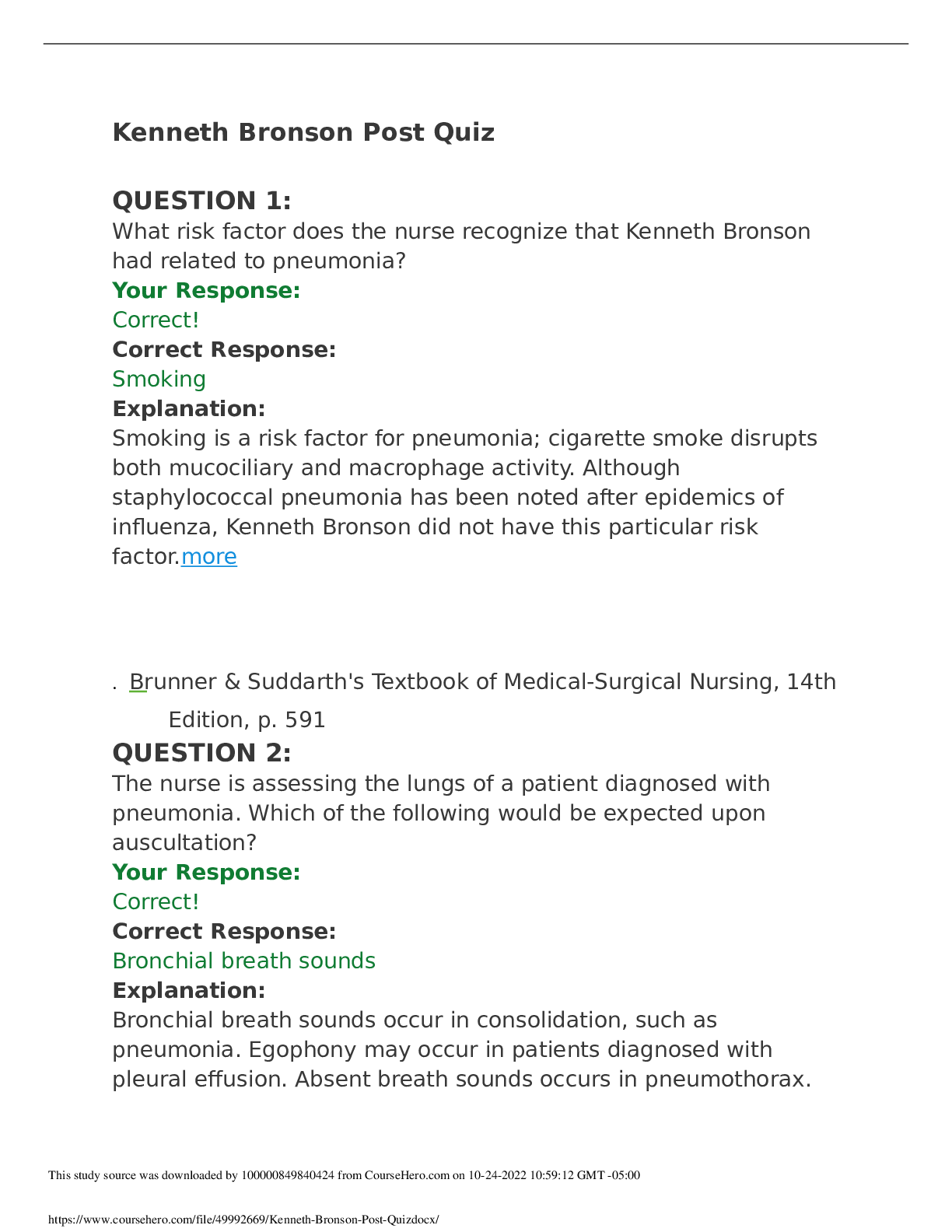



 Questions and Answers 100% VERIFIED.png)
 Questions and Answers 100% correct Solutions.png)







